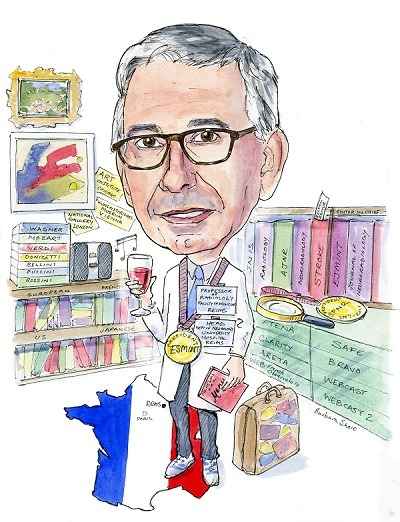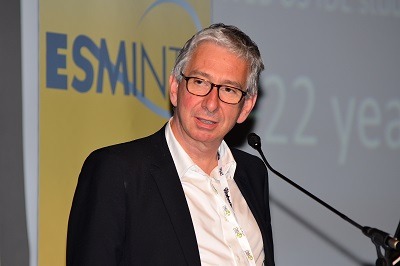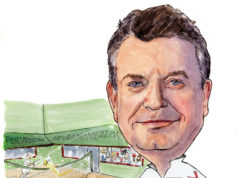 Laurent Pierot chose a career in medicine in order to have the skills to help people on a global level. Now, as the current president of ESMINT, his main goal is helping to further educate in the field of interventional neuroradiology. He tells NeuroNews about his plans for the future of the society, the advice he hopes his students will always follow and his interests outside of medicine.
Laurent Pierot chose a career in medicine in order to have the skills to help people on a global level. Now, as the current president of ESMINT, his main goal is helping to further educate in the field of interventional neuroradiology. He tells NeuroNews about his plans for the future of the society, the advice he hopes his students will always follow and his interests outside of medicine.
What drew you to medicine and how did you start your career in interventional neuroradiology?
I decided to pursue a medical career in order to develop professional skills and experiences that would help people on a global basis. For example, establishing a strong training partnership in Vietnam with Bach Mai Hospital (Hanoi) and Professor Pham Minh Thong in 1999 reveals that medicine was an excellent choice for me.
My initial residency began in neurology. At that time, active therapies in the field were in short supply. For instance, the management of acute ischaemic stroke was limited to imaging that was usually delayed and constrained by relatively few medical treatments. Concurrently, neuroradiology emerged as an innovative subspecialty for both diagnosis and treatment, and CT and MR were very promising tools that revolutionised the diagnostic approach for multiple neurological diseases. Having realised that interventional neuroradiology offered innovative treatment modalities for vascular brain diseases such as carotid-cavernous fistulas, aneurysms, brain AVMs, etc., and after an unsuccessful stint in Parkinson’s disease research, I finally decided to change specialities and shifted to neuroradiology because in France, physicians may only choose one speciality.
Who were your mentors and how did they influence you?
When I began my neuroradiology training, France’s main neuro centre was based at La Salpetriere Hospital, where I pursued residency and fellowship training in diagnostic neuroradiology with Professors Jacques Chiras and Didier Dormont. During my residency, I was lucky enough to hear Professor Jacques Moret deliver a very didactic yet provocative lecture about aneurysm treatment during a European congress. Several weeks later I met Professor Moret in his Foundation Rothschild Hospital department and he agreed to train me in interventional neuroradiology. In no uncertain terms, Professor Moret is a gifted teacher not only with expertise in interventional neuroradiology techniques, but is equally committed to integrating a strong focus on anatomy, physiology, a strategy of treatment and innovative approaches.
Additionally, I had the chance to be trained more or less at the same time as Professors Christophe Cognard and Laurent Spelle. For the past 25–30 years, we have benefitted from sharing our experiences and have held countless discussions on various topics (some heated, some not!), which has led to a very strong friendship.
Which innovations in interventional neuroradiology have shaped your career?
At the outset of my interventional neuroradiology training, endovascular approaches for intracranial aneurysms were based on microballoons! In the early 90s, controlled-detachable coils (GDC) became the first revolution in the interventional neuroradiology field. As endovascular treatment of intracranial aneurysms became more reliable, safer and no longer restricted to surgical contraindication, Professor Andy Molyneux’s ISAT study confirmed the superiority of coiling versus clipping in the management of ruptured aneurysms. This led to a significant increase in the number of aneurysms treated endovascularly.
Twenty-five years later, mechanical thrombectomy with stent retrievers for managing acute ischaemic stroke has kickstarted the second interventional neuroradiology revolution; this therapy will significantly impact interventional neuroradiology given its demanding activity in terms of manpower and organisation of interventional neuroradiology centres.
What has been the biggest disappointment—i.e. something you thought would be practice-changing but was not?
My biggest disappointment came during the session dedicated to stroke trials (IMS III and others) in Honolulu (2013 International Stroke Conference). Three randomised controlled trials (RCTs) were negative and the impression was that 30 years after Professor Hermann Zeumer’s initial publication we were back at the starting line. As a side note, these RCTs were fully analysed in the weeks following the 2013 Conference and it was clear that they had multiple drawbacks. This example shows that inappropriately conducted RCTs may lead to negative results that will prevent a large number of patients from accessing or benefiting from innovative treatment.
In contrast, two years later, MR CLEAN was positive and established the benefit of mechanical thrombectomy versus medical treatment, which has been confirmed by all the other RCTs dedicated to this topic.
You have been principal investigator of a number of trials of the WEB device. Do you think it is a game-changer in the treatment of intracranial aneurysms?
This is exactly the subject I will discuss at our next ESMINT meeting in Nice! However, it is important to note that for the first time, several good clinical practice studies (WEBCAST, WEBCAST-2, French Observatory, WEB-IT) have evaluated an innovative interventional neuroradiology technology from its introduction in the clinical field. These studies all show similar results: aneurysm treatment with WEB is exceptionally safe and associated with good anatomical results at midterm. Saying that, to have a clear understanding of this innovative treatment’s therapeutic benefit, we need to know the stability of aneurysm occlusion it offers in long-term follow-up. In essence, while the studies reveal that WEB is a very useful treatment for wide-neck bifurcation aneurysms, the question—depending on the stability of aneurysm occlusion—remains whether WEB can be expanded to include more commonly found aneurysms such as narrow neck or sidewall aneurysms.
What other technology are you keeping an eye on?
For aneurysm treatment, current research remains focused on devices which close the aneurysm neck. Currently, flow disruptors and other devices can close the neck from inside the aneurysm, while flow diverters and other devices can close the neck from outside, i.e., from the parent vessel. Nonetheless, devices placed in the parent vessel are often suboptimal in that dual antiplatelet treatment is required to avoid (or reduce) thromboembolic complications. Modifying the surface of the flow diverters may potentially allow reduction of antiplatelet treatments and expanded indications for ruptured aneurysms. Devices placed in the aneurysm are also disadvantageous in that the devices typically occupy some aneurysm volume, therefore limiting the reduction in the aneurysm size. Thus, it is likely wise to use devices that close the neck from inside the aneurysm but have limited volume.
For stroke treatment, the question is different. Stent retrievers are highly efficacious. Yet, aspiration, while a useful adjunctive tool, has not demonstrated superiority versus stent retrievers. The question then is not only technical, but includes how to offer this treatment to more patients without having a high number of futile recanalisations. What’s more, based on appropriately conducted RCTs, it appears that patient selection with imaging or other criteria and indications for treatment continue to require refinement, which is why the DAWN trial focused on enlarging of the time window using specific imaging criteria. Finally, one issue with mechanical thrombectomy is the risk of distal emboli; therefore, future technical developments dedicated to reducing this complication will be interesting to consider.

What are your main goals for your ESMINT presidency?
ESMINT’s primary mission is to provide continuing education and training for physicians practicing interventional neuroradiology. The ESMINT Board was elected in September 2016 for a two-year term, with Dr Patrick Brouwer as General Secretary and Professor Jens Fiehler as Treasurer, and is committed to developing a number of goals and objectives.
Education is ESMINT’s main priority, which led, in 2014, to the creation of a theoretical course for interventional neuroradiology trainees—ECMINT—directed by Shelley Renowden and James Byrne. This two-year, four-session course provides basic knowledge (anatomy, physiology, pharmacology, etc.) as well as knowledge regarding endovascular treatment of stroke, aneurysms, brain AVMs and fistulas, etc. Recently, ESMINT’s Board has decided to expand the number of ECMINT 3 participants to 100–120 (compared to 75 during the last session in June 2017). Additionally, ESMINT plans to organise a separate course dedicated to stroke management.
ESMINT will also continue to organise the Nice Congress in September, which is now firmly established as an important interventional neuroradiology meeting.
In parallel to these two important activities, and with the active involvement of Professor Zsolt Kulcsar, ESMINT has recently created webinars. The first webinars were organised around acute ischaemic stroke treatment and were well attended by 80–100 participants. The next set of webinars are focused on aneurysm treatment, and we expect greater interest.
In December 2016, ESMINT created the European Board of Neuroradiology (EBNI) chaired by Olof Flodmark, which includes ESMINT, ESO (European Stroke Organisation) and EANS (European Association of Neurological Societies) representatives (the European Society of Neuroradiology [ESNR] declined to participate). This Board is very important since it will propose rules for accrediting already-practicing interventional neuroradiology physicians, physicians in training, interventional neuroradiology centres and interventional neuroradiology training centres. The Board will then review the trainee, physician and centre files submitted for approval.
Positive RCTs for mechanical thrombectomy have initiated increased activity in this field with an urgent need for qualified physicians to deliver this therapy. The ESO/ESMINT/SAFE survey has shown that experts are sorely lacking in many European countries. Consequently, ESMINT will develop and implement (likely in 2018) a fellowship programme dedicated to trainees interested in training at high volume interventional neuroradiology training centres. We are pleased to announce that this programme will be designed with industry support.
Where and how do you see society growing and developing in the future?
In addition to its educational activities, ESMINT wants to build a European network of interventional neuroradiology centres dedicated to stroke and aneurysm treatment as well as other activities (AVM or fistula treatment, for instance).
ESMINT also intends to establish strong relationships with “sister” societies such as ESO and EANS. To this end, ESO and ESMINT recently developed and agreed a memorandum of understanding (MOU) in order to reinforce collaboration between both societies.
Currently, ESMINT is actively working with SNIS, WFITN and other societies to establish rules concerning training and practice of interventional neuroradiology in the world.
What advice do you hope your mentees/students will always follow?
The main point of our practice is always to offer the best therapeutic management we can to our patients which means selecting the right indication and the correct treatment, giving patients and families all the necessary information to understand the treatment strategy and properly organise follow-up.
What has been your most memorable case?
For me, memorable cases are those with life-threatening complications rather than cases that conclude with a successful and/or easy treatment. One particularly memorable case involved a relatively young woman (between 40 and 50), whom I treated in Foch Hospital more than 20 years ago: a ruptured left vertebral artery aneurysm treated roughly 10 days after the initial rupture (there was some delay in diagnosis at another hospital). The story is unfortunately simple: rupture during placement of the first coil, contrast extravasation, blood pressure increase, bilateral mydriasis and death after a few minutes.
To be sure, there is nothing special with this case and I have treated many subsequent aneurysms. However, what is important to me is that that evening, Professor Patrick Derome, head of the Neurosurgery Department, called me (I was the head of the Neuroradiology Department) and spoke two unforgettable sentences: “I know what you are feeling. This type of terrible complication can happen to all of us.”
What are your interests and hobbies outside of medicine?
I love literature (especially European and French, but American and Japanese as well), music—especially opera (Mozart, Italian including Verdi, Donizetti, Bellini, Puccini, Rossini and others, and the most important one: Wagner, even though I am uncomfortable with his “ideology”)—and paintings. Spending time in art museums is a great passion, and among my favourites are the Art Institute in Chicago (with a wonderful Impressionism collection), the Kunsthistorishes Museum in Vienna (with lovely Bruegel paintings) and the National Gallery in London. I also deeply enjoy visiting contemporary art museums for their innovative architecture and, ironically, their often disappointing content.
Travelling all around the world (Asia, America, Europe, Africa) is also a passion because it allows me to experience different cultures and explore diverse life approaches, not to mention enjoy new and interesting cuisines!
Unfortunately (and it is visible!), I have little interest in sport, but, to keep fit, I run several times per week.
Unfortunately (and it is also visible!), I have a deep and abiding affection for good food and delicious wine (but by French Law its is forbidden to say that!).
Finally, I have three wonderful children (two daughters: 27 and 25 and one son: 23) with whom I am very close and enjoy every opportunity to spend time with them.
Fact file
Current position
Professor of Radiology in the Faculty of Medicine of Reims and head of the Department of Neuroradiology in University Hospital in Reims, France
Training
Interventional neuroradiology, Foundation Rothschild Hospital, Paris, France
Society positions
- 2016–present President, European Society for Minimally Invasive Neurological Therapies (ESMINT)
- 2007–2011 President, French Society of Neuroradiology (SFNR)
Journals
- Editor-in-chief, EJMINT
- Editor-in-chief, Journal of Neuroradiology
- Section editor (interventional radiology), Stroke
- Editorial Board, American Journal of Neuroradiology (AJNR)
- Editorial Board, Neuroradiology
Research
Principal investigator for:
- ATENA,
- CLARITY,
- ARETA,
- WEB French Observatory,
- SAFE,
- BRAVO,
- WEBCAST,
- WEBCAST2.











